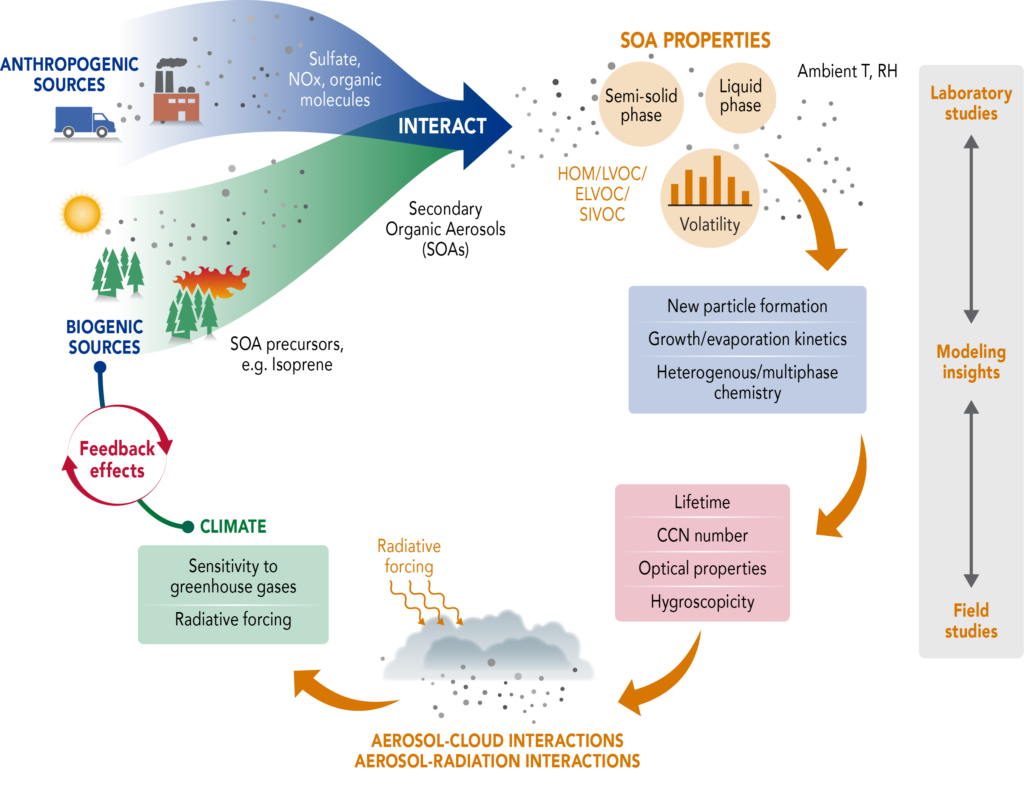Aerosols, tiny particles in the atmosphere, influence cloud-forming processes, scatter and absorb solar light and thus alter the climate. A recent review article published in Reviews of Geophysics focused on one particular type of aerosol, secondary organic aerosol (SOA), highlighting recent developments in understanding about the formation and properties of SOA, and discussing how these developments could impact estimates of global climate forcing. The editors asked one of the authors to explain the significance of SOA and suggest where further research efforts are still needed to better understand their influence on climate.
What is “secondary organic aerosol” and why is it important?
Unseen by the naked eye, large quantities of carbon-containing vapors enter the atmosphere as they are released from trees and escape during the combustion of fossil and biomass fuels. The atmosphere serves as a large chemical reactor, “cooking” these emissions and transforming them chemically into new molecules with new properties. Some of these molecules can stick together, forming new particles, or condense onto existing particles; the condensed material is commonly referred to as “secondary organic aerosol”.
Secondary organic aerosol is important because it is a major fraction of global submicron-sized atmospheric organic aerosol. SOA can cool or warm the atmosphere by changing the amount of solar energy reaching the Earth’s surface. SOA processes could also result in formation of new particles that act as cloud condensation nuclei, affecting clouds and precipitation.
In the last decade, great advances have been made in terms of understanding how SOA particles form, what are their properties, and how they evolve in the atmosphere as a function of temperature and relative humidity. These advances have major implications in terms of representing processes related to the atmospheric lifecycle of SOA in models. This work critically assesses the understanding developed in the last decade and outlines several future research directions that are needed to address the outstanding issues in SOA.

What are the challenges of accounting for secondary organic aerosol in climate models?
SOA represents a complex aerosol system that involves thousands of organic species in both gas and particle phases. Although the understanding of SOA formation and properties has greatly advanced in the past decade, substantial gaps remain.
A better understanding of SOA formation mechanisms is needed. In addition to their volatility, the condensation of molecules onto particles can also be impacted by the phase of the particles, with uptake and mixing limited in highly viscous particles. Ultimately, all important processes that shape atmospheric aerosol size distributions and concentrations of cloud condensation nuclei need to be adequately represented in climate models.
The computational burden associated with advection of gas- and particle-phase SOA species could be a major challenge. To this end, efforts are needed to determine the most influential non-linear processes affecting SOA, so that they can be efficiently represented in atmospheric chemistry-climate models.
What are the major unsolved or unresolved questions in this field?
As the understanding of SOA formation processes evolves, an important question is how this new understanding affects our estimates of aerosol climate forcing, which is calculated as the difference between present-day and pre-industrial conditions. Of particular interest are processes wherein anthropogenic emissions interact with biogenic emissions and affect the chemical mechanisms of SOA formation. However, currently, we only understand a small subset of these processes, and even this subset is not holistically represented in climate models.
Also, the natural background aerosol state strongly affects calculations of aerosol climate forcing, but is not accurately characterized, in large part because we cannot go back in time and measure past aerosol concentrations, as has been done for greenhouse gases. Thus, we are highly reliant on process-level understanding of the atmospheric lifecycle of particles in general, and SOA specifically, when assessing the climate impacts.
How could additional data or modeling efforts contribute to a better understanding?
Integrated measurements and modeling efforts are needed to determine the non-linear effects of SOA on clouds and radiation. It is important to continuously develop experimental techniques that provide information about the entire lifecycle of SOA, beginning with formation of molecular clusters to their growth to particle sizes that enable the particles to function as cloud condensation nuclei.
New model parameterizations will need to be developed and these model predictions will need to be validated with as many experimental constraints as possible, to ensure accuracy and ascertain that we are getting the right answers for the right reasons.
—Manishkumar Shrivastava, Pacific Northwest National Laboratory, Washington; email: [email protected]
Citation:
Shrivastava, M. (2017), Tiny particles with big impact on global climate, Eos, 98, https://doi.org/10.1029/2018EO077803. Published on 24 July 2017.
Text © 2017. The authors. CC BY-NC-ND 3.0
Except where otherwise noted, images are subject to copyright. Any reuse without express permission from the copyright owner is prohibited.

